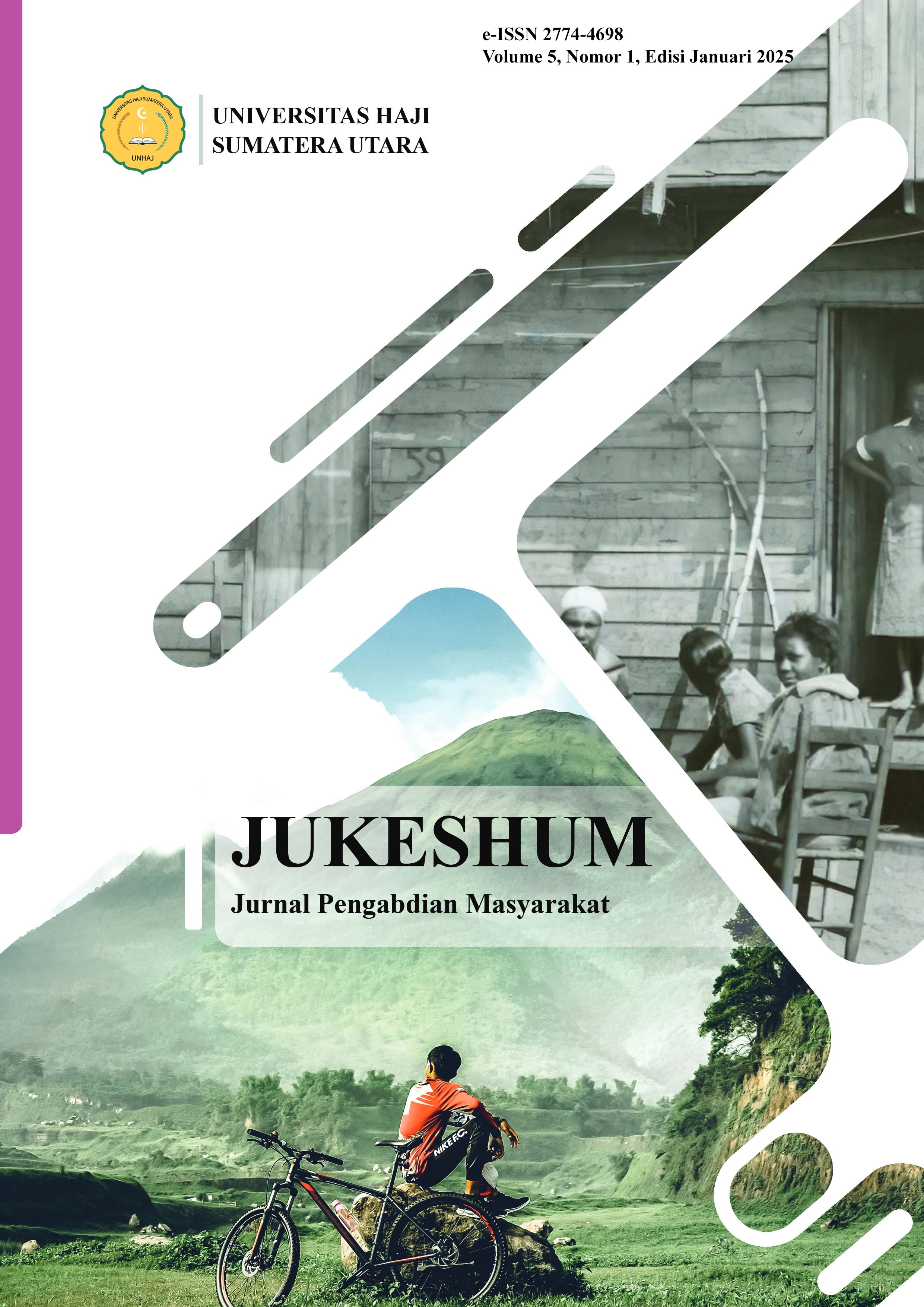Family Based Education in Prevention of Anemia In Pregnant Women in Bandar Khalifah Village Percut Sei Tuan
Pendidikan Berbasis Keluarga Dalam Pencegahan Anemia Pada Ibu Hamil di Desa Bandar Khalifah Percut Sei Tuan
DOI:
https://doi.org/10.51771/jukeshum.v5i1.1011Keywords:
Education, Family, Anemia PreventionAbstract
Cases of anemia caused by malnutrition, especially iron deficiency anemia, reach 75%. The prevalence of iron and other micronutrient deficiencies is a serious problem in developing countries. The incidence of anemia or lack of blood among pregnant women in Indonesia is still relatively high, at 48.9%. Anemia is closely related to malnutrition, which is a multifactorial influence and interaction between food intake and frequency of infection. The prevalence of anemia among pregnant women at the Bandar Kalipah Community Health Center was recorded at 24.9%. The community service method applied in this activity directly involves families in efforts to reduce the incidence of anemia in pregnant women, through lectures, counseling, discussions, and training. As an initial step, a pre-test and post-test analysis was carried out to measure family knowledge about anemia, in order to ensure an increase in family knowledge and participation in efforts to prevent anemia. The knowledge of pregnant women's families before (pre-test) and after (post-test) being given education on preventing anemia through family-based education showed good results, with a percentage of good knowledge of 23.29% in the pre-test and increasing to 92.0% in the post-test. Sufficient knowledge was recorded at 24.70%, while low knowledge decreased to 3.00%. This activity aims to provide education to families who accompany pregnant women and is carried out repeatedly and consistently in Bandar Khalifah Village, where pregnant women must be accompanied by their families during pregnancy check-ups. This activity was carried out in October 2024 by providing education on the causes of anemia, the process of anemia, prevention of anemia, and proper treatment for anemia. With this activity, there was an increase in knowledge, attitudes, and experience for families of pregnant women in efforts to prevent anemia.
References
Atzmardina, Zita. (2022). Skrining dan Penyuluhan Sebagai Upaya Penurunan Kasus Anemia Pada Ibu Hamil di Puskesmas Cikupa. Seri Seminar Nasional Ke-IV Universitas Tarumanagara Tahun 2022, 1527-1534.
Bariyyah, Khoirul. (2021). Status Gizi Ibu Sebelum Hamil Dan Status Anemia Ibu Hamil Meningkatkan Resiko Melahirkan Bayi Berat Lahir Rendah.
BPS. (2024). Prevalensi Anemia Berdasarkan Kelompok Umur.
Kemenkes, RI. (2023). Profil Kementerian Kesehatan Republik Indonesia.
Lasria Yolivia Aruan. (2022). Pemberdayaan Masyarakat Dalam Upaya Pencegahan Dan Penanganan Anemia Pada Ibu Hamil Di Puskesmas Pembantu Bandar Klippa Kecamatan Percut Sei Tuan Kabupaten Deli Serdang Tahun 2022. NUSANTARA Jurnal Pengabdian Kepada Masyarakat, 110-115.
Mulia, Sri. (2021). Faktor yang Berhubungan dengan Perilaku Pencegahan Anemia pada Ibu Hamil. Darussalam Indonesian Journal of Nursing and Midwifery.
Profil Kesehatan Deli Serdang. (2019). Profil Kesehatan Deli Serdang.
Profil Kesehatan Sergei. (2023). PROFIL KESEHATAN .
Putri. (2024). Edukasi Pencegahan Anemia Pada Kehamilan Berbasis . 1320-1327.
WHO. (2001). Iron Deficiency Anaemia Assessment, Prevention, and Control A guide for programme managers. World Health Organization.
WHO. (2019). 主観的健康感を中心とした在宅高齢者における 健康関連指標に関する共分散構造分析.
Wibowo, Norouono. (2021). Anemia Defesiensi Besi Pada Kehamilan. Jawa Barat: UI Publishing.
Wiratma, Dicky Yuswardi. (2021). Pencegahan Anemia Melalui Pemberian Suplemen Zat Besi pada Ibu Hamil di Puskesmas Bandar Khalipah Kecamatan Percut Sei Tuan.
Downloads
Published
Issue
Section
License
Copyright (c) 2025 Riska Susanti Pasaribu, Lidya Natalia Sinuhaji, Ridesman Ridesman, Lasria Simamora, Siska Suci Triana Ginting, Marlina Simbolon

This work is licensed under a Creative Commons Attribution-ShareAlike 4.0 International License.
Hak Cipta dan Lisensi
Penulis yang mempublikasikan naskahnya melalui Jukeshum: Jurnal Pengabdian Masyarakat menyetujui beberapa hal berikut:
- Hak Cipta atas naskah-naskah karya ilmiah di dalam Jurnal ini dipegang oleh Penulis.
- Penulis menyerahkan hak saat pertama kali mempublikasi Naskah karya ilmiahnya dan secara bersamaan Penulis memberikan izin/lisensi dengan mengacu pada Creative Commons Attribution-ShareAlike 4.0 International License kepada pihak lain untuk menyebarkan karya ilmiahnya tersebut dengan tetap mencantumkan penghargaan bagi penulis dan Jukeshum: Jurnal Pengabdian Masyarakat sebagai media Publikasi pertama atas karya tersebut.
- Hal-hal yang berkaitan dengan non-eksklusivitas pendistribusian Jurnal yang menerbitkan karya ilmiah penulis dapat diperjanjikan secara terpisah (contoh: permintaan untuk menempatkan karya yang dimaksud pada perpustakaan suatu institusi atau menerbitkannya sebagai buku) dengan Penulis sebagai salah satu pihak perjanjian dan dengan penghargaan pada Jukeshum: Jurnal Pengabdian Masyarakat sebagai media publikasi pertama atas karya dimaksud.
- Penulis dapat dan diharapkan untuk mengumumkan karyanya secara online (misalnya pada Repositori atau pada laman Organisai/Institusinya) sejak sebelum dan selama proses pengumpulan naskah, sebab upaya tersebut dapat meningkatkan pertukaran citasi lebih awal dan dengan cakupan yang lebih luas.








